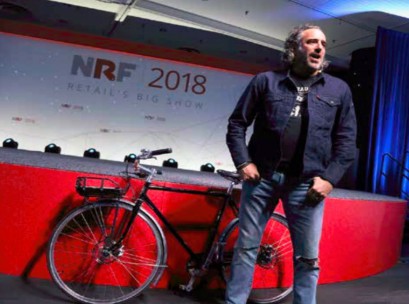 NEW YORK CITY, USA – James Curleigh, head of brand at Levi Strauss & Co, made quite the entrance at the NRF Big Show in New York City on Sunday.
NEW YORK CITY, USA – James Curleigh, head of brand at Levi Strauss & Co, made quite the entrance at the NRF Big Show in New York City on Sunday.
With Bob Dylan’s The times they are a-changin’ playing in the background, Curleigh cycled up to the main stage – all the better to show off his commuter jacket, a piece of wearable technology from Levi’s recent collaboration with Google.
The theme song was apropos of the current retail climate, he noted, as the foundations of distribution, marketing and customer experience continue to shift beneath retailers’ feet.
There are no guarantees of success even for an iconic brand like Levi’s, Curleigh said, “but what we can guarantee is setting the conditions of success.”
At the heritage denim company, that means striking a strategic balance between the fundamentals of traditional retail and all the opportunities and possibilities of the digital future.
“It’s not one way or the other, we’re this, we’re that,” Curleigh said. “[It’s about] the introduction of the word ‘and’, doing more and creating synergy, where the whole of the Levi’s brand is greater than the sum of its parts.”
In the wrong hands, such a strategy could easily devolve into an attempt to be everything to everyone. However, Curleigh is advocating for a best-of-both-worlds scenario – a sort of business ‘mullet’ if you will.
“What did [the mullet] say? It said business in the front, party in the back. The new brand of business mullet should be simple in the front, sophisticated in the back,” he said, noting that powerful brands like Google and Tesla do this well.
“Let’s face it…there are more choices, more angst points and more obstacles than ever before. In a world of difficult decisions, picking out a pair of jeans should not be one of them,” he said.
Heritage and innovation
One area where Levi’s is looking to strike this strategic balance is between brand heritage and innovation. As Curleigh pointed out, if Levi’s doesn’t leverage its iconic status – think the red tab, rivet, button fly and classic five-pocket style – who else will?
“At the same time, how do we leverage [these features] to be more relevant in future, than they were in the past…We have to lean into innovation. Not just through our partnership with Google and wearable technology, but also our Eureka Innovation Lab in San Francisco and Levi’s stadium in Santa Clara [home of the 49ers football team],” he said.
As an example of this, the company last year invited Chance the Rapper, Solange Knowles and other celebrities to design limited editions of its iconic ‘trucker jacket’ to celebrate the 50th anniversary of the style.
“We’re connecting with the next generation of fans in a way that, in some cases, we didn’t anticipate,” Curleigh said.
Access and aspiration
Another area where Levi’s is seeking a strategic balance is between access and aspiration. The adoption of new sales and distribution channels, including e-commerce and bricks-and-mortar stores, has gone a long way to increasing consumer access to Levi’s products.
The brand has also partnered with second-hand denim business Redone to increase its presence in the vintage jeans market and collaborated with fashion icon Diane von Furstenberg on a recent pop-up in San Francisco.
At the same time, Levi’s is investing in the aspirational nature of its brand – not necessarily in terms of price, but rather its status as a cultural symbol. This can be seen in the 2017 release of its “Circles” ad.
A grittier version of the global feel-good spots from Coca-Cola, the video features groups of people all over the world dancing to the song, ‘Makeba’, by French singer Jain. In a matter of weeks, the ad cracked the top 10 ads on YouTube and drove more positive feedback than anything the company had done in the past 20 years, according to Curleigh.
“It truly reenergised our organisation and gave us the confidence that we could present ourselves beyond the skinny jean,” he said.
Ultimately, this balancing act is about both delivering what customers expect and surprising them with the unexpected.
“It’s expected that we have points of distribution, that the product is actually there and their size is actually available. There are tried-and-trusted ways to provide service and [this] has never been more important,” Curleigh said.
“At the same time, [we need] to bring the unexpected, something the fan didn’t expect, but when they remember it, they tell the story again and again and again.”





